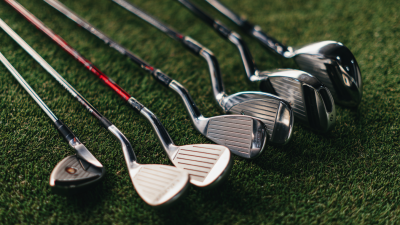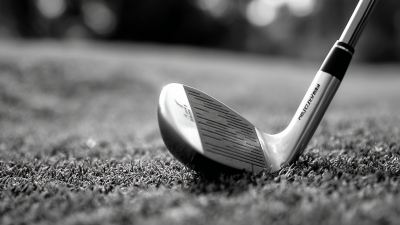The Ultimate Guide to Choosing the Best Men's Golf Clubs for Every Skill Level
When it comes to selecting the best mens golf clubs, understanding the nuances of each club type and how they align with skill levels is crucial. According to the National Golf Foundation, approximately 24 million Americans play golf, with over 80% of them investing in equipment that best suits their game. The right set of mens golf clubs can significantly enhance both performance and enjoyment on the course. Moreover, the Golf Equipment Market is projected to reach $3.5 billion by 2024, with advancements in technology and materials leading to more tailored options for novices to professionals. Therefore, whether you’re just starting out or looking to refine your skills, this guide will walk you through essential considerations to ensure you make an informed choice that complements your golfing journey.

Factors to Consider When Choosing Golf Clubs for Different Skill Levels
When choosing golf clubs, skill level is a crucial factor to consider. For beginners, clubs with larger sweet spots and more forgiving designs are ideal. These clubs, such as cavity-back irons, help in making consistent contact with the ball, boosting confidence and encouraging practice. Additionally, a lighter shaft will aid in better swing dynamics for novices, which can lead to improved distance and accuracy.
Intermediate players often seek a balance between forgiveness and control. This is the stage where golfers can benefit from clubs that offer a good level of feedback while still providing the necessary playability. Many in this category may prefer a mix of cavity-back and blade irons, as well as hybrid clubs that combine the easy launch of woods with the accuracy of irons.
Finally, advanced golfers prioritize precision and shot-shaping capabilities, frequently opting for specialized equipment that complements their unique swing characteristics, such as adjustable driver lofts or forged irons that provide maximum feedback and control during play.
Understanding the Importance of Club Fitting in Maximizing Performance
When it comes to maximizing your performance on the golf course, understanding the importance of club fitting is essential. Properly fitted golf clubs can significantly improve your swing mechanics, control over the ball, and overall enjoyment of the game. Whether you are a novice or an experienced player, club fitting ensures that your equipment is tailored specifically to your body type, swing style, and skill level. This personalized approach can help you achieve better accuracy and distance, leading to an enhanced golfing experience.
**Tips for Effective Club Fitting:**
1. Consult a Professional: Seek the expertise of a certified club fitter who can analyze your swing and recommend suitable equipment based on your unique needs.
2. Test Different Lengths and Flexes: Experimenting with various shaft lengths and flex levels can reveal which specifications best complement your swing dynamics.
3. Consider Your Playing Style: Be honest about your playing style—whether you prefer a more aggressive long game or a strategic approach—so that your clubs align with your goals.
Club fitting is not just a one-time event but an ongoing process. As your skills develop and your swing evolves, revisit fitting sessions to ensure your clubs remain optimized for your performance. This level of attention can unlock your potential on the green and make each round more enjoyable.
Assessing the Role of Shaft Flexibility and Material in Gameplay
When selecting men's golf clubs, shaft flexibility and material play a crucial role in enhancing a player's performance on the course. Shaft flexibility affects how the club interacts with the ball upon impact, influencing both distance and accuracy. Generally, golfers with faster swing speeds benefit from stiffer shafts, as they provide more control and stability. Conversely, players with slower swing speeds may find that a more flexible shaft helps them generate additional clubhead speed and distance. Understanding one’s swing mechanics is essential for making the right choice in shaft flexibility.
In addition to flexibility, the material of the shaft—typically steel or graphite—also significantly impacts gameplay. Steel shafts are known for their durability and are favored by players seeking greater control and feedback. They offer a lower trajectory which can suit players who have consistent swings. On the other hand, graphite shafts are lighter and can aid in increasing swing speed, making them popular for beginners and senior golfers. The choice between these materials depends on individual preferences, skill levels, and playing styles, ultimately affecting overall performance on the course.
Comparing Driver Types: Advantages of Metal vs. Composite Materials
When it comes to selecting the best golf clubs, understanding the materials used in drivers is crucial, especially for players at all skill levels. The ongoing debate between metal and composite materials highlights distinct advantages that can impact performance on the course.
Metal drivers, typically crafted from titanium or stainless steel, provide durability and a higher degree of forgiveness on off-center hits, making them ideal for beginner and intermediate golfers looking to improve their consistency. The robust nature of metal also allows for larger clubheads, which can enhance the sweet spot, further aiding in distance and accuracy.
On the other hand, composite materials offer unique benefits that can appeal to more advanced players. These drivers often feature a lighter construction, allowing for increased swing speed and maneuverability. The design flexibility of composites enables engineers to fine-tune weight distribution, resulting in optimized launch angles and spin rates. Additionally, composite drivers can help to dampen vibrations on impact, providing a more comfortable feel. Understanding these differences will help golfers make informed decisions based on their personal preferences and playing styles, ultimately contributing to improved performance on the links.
Budgeting for Quality: What to Expect at Different Price Points in Golf Clubs
When selecting golf clubs, understanding the pricing spectrum is crucial for making an informed choice without overspending. Budget options typically range from $200 to $500 and are great for beginners looking to find their rhythm without a hefty investment. Clubs in this category often offer satisfactory performance and durability but may lack the advanced technology and design features found in higher-priced options. These clubs serve well for honing basic skills and understanding the game mechanics.
As golfers progress, they may consider mid-range clubs priced between $500 and $1,500. This tier introduces improved materials, better ergonomics, and enhanced performance features, which can significantly aid in skill development. For serious enthusiasts and competitive players, high-end clubs costing $1,500 and up present the most advanced technology, tailored options, and superior craftsmanship. Investing at this level can lead to notable improvements in play, provided the golfer is ready to leverage such benefits effectively. Ultimately, while it’s vital to set a budget, it's equally important to consider how each price point aligns with individual skill levels and golfing goals.
The Ultimate Guide to Choosing the Best Men's Golf Clubs for Every Skill Level - Budgeting for Quality: What to Expect at Different Price Points in Golf Clubs
| Price Range | Skill Level | Features | Typical Materials |
|---|---|---|---|
| Under $300 | Beginner | Basic design, forgiving clubs, lightweight | Vinyl grips, stainless steel, entry-level composites |
| $300 - $700 | Intermediate | Improved technology, better materials, enhanced performance | Graphite shafts, multi-material construction, rubber grips |
| $700 - $1,200 | Advanced | Precision engineering, custom fitting options, premium feel | High-grade steel, carbon fiber, advanced rubber compounds |
| Over $1,200 | Professional | Custom-made clubs, tour-level performance, maximal control | Titanium, exotic materials, bespoke components |
Related Posts
-

Elevate Your Game with the Ultimate Golf Club Set for Every Skill Level
-

The Ultimate Guide to Choosing Kids Golf Clubs for Young Golfing Enthusiasts
-

The Ultimate Guide to Choosing the Right Golf Club Set for Beginners
-

The Ultimate Guide to Choosing the Perfect Golf Set for Every Skill Level
-

Ultimate Guide to Choosing the Best Golf Travel Bags for Your Next Golf Adventure
-

Mastering Your Short Game with the Best Golf Wedges for Every Skill Level
